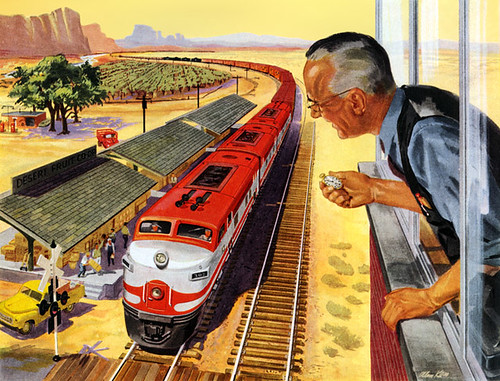From the Seattle Times: Chicago-bound Amtrak train derails near Spokane
By The Associated Press
SPOKANE, Wash. — A Chicago-bound Amtrak passenger train derailed early Saturday near Spokane, but there were no serious injuries.
Minor injuries to a few of the 86 passengers and six crew members on the eastbound Empire Builder were treated at the high school gymn in the town of Sprague, near the accident site about 45 miles west of Spokane, said Amtrak spokeswoman Tracy Connell.
Passengers were then bused to hotels in Spokane, where they will hope to resume their journey on Saturday night's Empire Builder, which travels between Chicago and Portland, Ore. There is one westbound and one eastbound train on the route daily.
The derailed train's engine and four cars remained upright after leaving the track, and equipment was brought in before dawn from Spokane and Pasco to rerail them, said Seattle spokesman Gus Melonas for Burlington Northern Santa Fe, which owns and maintains the tracks.
Fort Worth, Texas-based BNSF expected to have the damaged single main-line track reopened within 24 hours, he said. In the meantime, some freight traffic will be detoured on alternate lines within the state.
Amtrak passengers will be bused between Spokane and Portland, Ore., during the interruption, Melonas said.
The cause of the derailment was under investigation, he said.
Copyright © 2006 The Seattle Times Company
A couple of notes:
First, this was only the Portland-Spokane section of the Empire Builder. It combines with the larger Seattle-Spokane-Chicago section at Spokane, and continues east as one train. That is why the train is so small - one locomotive and four cars. The combined Builder is probably three locomotives and 8-10 cars.
I don't know what track BNSF is planning to detour on. The only ways to detour trains is either go all the way up to Seattle and over a very congested Stevens Pass, or detour on the Union Pacific line between Pasco, WA, and Spokane. My guess is probably detour a couple of high-priority trains on the latter. Incidentally, the old BN used to have a well-engineered second line between Pasco and Spokane - and abandoned it in 1987.
Rough weekend up in Washington State. And lloks like it will be a while before it gets better - according to this Seattle Times article, BNSF maintenance-of-way crews have had their hands full, with multiple slides between Seattle and Everett and between Tacoma and Chehalis, as well as the Empire Builder derailment.
Scratch-Pad Ramblings:Lurching South - The Saga of the Nevada WesternI warned you watching train videos and reading train books can be a bad idea.

Yet another train layout concept has been born; a line running from Nowhere, Nevada, to Where-in-the-heck-are-we, California.
Actually, there would be a point to this line; and, it would be connecting actual towns. I actually wouldn't be doing much grading of new line.
Ninety years ago, the railroad map of Nevada looked considerably different. (From Nevada Northern & the Railroads of White Pine County.) A plethora of exotic-sounding shortlines ran down the California-Nevada border, connecting Reno with Las Vegas: Virginia & Truckee ("Queen of the Shortlines"), Carson & Colorado, Tonopah & Goldield, Bullfrog & Goldfield, Las Vegas & Tonopah, Tonopah & Tidewater...
But connecting Nevada's two biggest cities is not the reason for their existence; at the time they were built, Las Vegas was a tiny tank town on the Union Pacific. No, these roads were built to move minerals to market. The last great American gold rush occurred in the 1900's; and they railroads were laid to the gold camps as fast as they could find the rails.
Most of the roads disappeared during or immediately after World War Two; FDR's ban on precious metal mining had destroyed the weak economies of the surviving mining towns. The V&T managed to hang on until 1950, until it, too, was scrapped.
But this free-lancing stuff is great for grim situations like this.
By a fortunate coincidence of history, the lines survived well into the late twentieth century. The oil wells near Tonopah proved more prolific than expected, and the mineral wealth of the high desert continued to fill the pockets of high desert industrialists. And explorations into the Eastern Sierra brought more - more opportunities (lumber), more traffic (more oil & minerals), and more business. And as Las Vegas grew, so did traffic from the north.
With the growth of Las Vegas into a booming business city as well as a resort destination (thanks to a business-friendly tax regime), the Western Pacific saw an opportunity for a piece of the action.
This is obviously just a developing concept, and needs a lot of work yet. But what do you think so far?
For inspiration and more information:
Nevada State Railroad Museum
Virginia & Truckee Railroad
Nevada Northern & the Railroads of White Pine County
Tonopah & Tidewater - A Study
Great Basin Research
Gordon Osmundson Photographs Back to
Scratch-Pad Ramblings.
